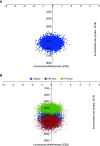Primary Care Physicians Can Comprehensively Manage Patients with Sleep Apnea. A Noninferiority Randomized Controlled Trial
- PMID: 29664672
- PMCID: PMC7252878
- DOI: 10.1164/rccm.201710-2061OC
Primary Care Physicians Can Comprehensively Manage Patients with Sleep Apnea. A Noninferiority Randomized Controlled Trial
Abstract
Rationale: General practitioners play a passive role in obstructive sleep apnea (OSA) management. Simplification of the diagnosis and use of a semiautomatic algorithm for treatment can facilitate the integration of general practitioners, which has cost advantages.Objectives: To determine differences in effectiveness between primary health care area (PHA) and in-laboratory specialized management protocols during 6 months of follow-up.Methods: A multicenter, noninferiority, randomized, controlled trial with two open parallel arms and a cost-effectiveness analysis was performed in six tertiary hospitals in Spain. Sequentially screened patients with an intermediate to high OSA probability were randomized to PHA or in-laboratory management. The PHA arm involved a portable monitor with automatic scoring and semiautomatic therapeutic decision-making. The in-laboratory arm included polysomnography and specialized therapeutic decision-making. Patients in both arms received continuous positive airway pressure treatment or sleep hygiene and dietary treatment alone. The primary outcome measure was the Epworth Sleepiness Scale. Secondary outcomes were health-related quality of life, blood pressure, incidence of cardiovascular events, hospital resource utilization, continuous positive airway pressure adherence, and within-trial costs.Measurements and Main Results: In total, 307 patients were randomized and 303 were included in the intention-to-treat analysis. Based on the Epworth Sleepiness Scale, the PHA protocol was noninferior to the in-laboratory protocol. Secondary outcome variables were similar between the protocols. The cost-effectiveness relationship favored the PHA arm, with a cost difference of €537.8 per patient.Conclusions: PHA management may be an alternative to in-laboratory management for patients with an intermediate to high OSA probability. Given the clear economic advantage of outpatient management, this finding could change established clinical practice.Clinical trial registered with www.clinicaltrials.gov (NCT02141165).
Keywords: cost-effectiveness; portable monitor; primary care; sleep apnea.
Figures



Comment in
-
Diagnosis and Management of Patients with Obstructive Sleep Apnea in Primary Care. Ready or Not?Am J Respir Crit Care Med. 2018 Sep 1;198(5):557-558. doi: 10.1164/rccm.201803-0555ED. Am J Respir Crit Care Med. 2018. PMID: 29694237 No abstract available.
References
-
- Durán J, Esnaola S, Rubio R, Iztueta A. Obstructive sleep apnea–hypopnea and related clinical features in a population-based sample of subjects aged 30 to 70 yr. Am J Respir Crit Care Med. 2001;163:685–689. - PubMed
-
- Marin JM, Carrizo SJ, Vicente E, Agusti AG. Long-term cardiovascular outcomes in men with obstructive sleep apnoea–hypopnoea with or without treatment with continuous positive airway pressure: an observational study. Lancet. 2005;365:1046–1053. - PubMed
-
- Barbé F, Durán-Cantolla J, Sánchez-de-la-Torre M, Martínez-Alonso M, Carmona C, Barceló A, et al. Spanish Sleep and Breathing Network. Effect of continuous positive airway pressure on the incidence of hypertension and cardiovascular events in nonsleepy patients with obstructive sleep apnea: a randomized controlled trial. JAMA. 2012;307:2161–2168. - PubMed
-
- Terán-Santos J, Jiménez-Gómez A, Cordero-Guevara J Cooperative Group Burgos-Santander. The association between sleep apnea and the risk of traffic accidents. N Engl J Med. 1999;340:847–851. - PubMed
-
- Masa JF, Rubio M, Findley LJ. Habitually sleepy drivers have a high frequency of automobile crashes associated with respiratory disorders during sleep. Am J Respir Crit Care Med. 2000;162:1407–1412. - PubMed
Associated data
LinkOut - more resources
Full Text Sources
Other Literature Sources
Medical

